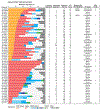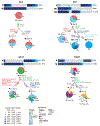Analysis of mutational signatures in primary and metastatic endometrial cancer reveals distinct patterns of DNA repair defects and shifts during tumor progression
- PMID: 30415991
- PMCID: PMC6726428
- DOI: 10.1016/j.ygyno.2018.10.032
Analysis of mutational signatures in primary and metastatic endometrial cancer reveals distinct patterns of DNA repair defects and shifts during tumor progression
Abstract
Objective: Mutational signatures provide insights into the biological processes shaping tumor genomes and may inform patient therapy. We sought to define the mutational signatures of i) endometrioid and serous endometrial carcinomas (ECs), stratified into the four molecular subtypes, ii) uterine carcinosarcomas, and iii) matched primary and metastatic ECs.
Methods: Whole-exome sequencing MC3 data from primary endometrioid and serous carcinomas (n = 232) and uterine carcinosarcomas (n = 57) from The Cancer Genome Atlas (TCGA), and matched primary and metastatic ECs (n = 61, 26 patients) were reanalyzed, subjected to mutational signature analysis using deconstructSigs, and correlated with clinicopathologic and genomic data.
Results: POLE (ultramutated) and MSI (hypermutated) molecular subtypes displayed dominant mutational signatures associated with POLE mutations (15/17 cases) and microsatellite instability (55/65 cases), respectively. Most endometrioid and serous carcinomas of copy-number low (endometrioid) and copy-number high (serous-like) molecular subtypes, and carcinosarcomas displayed a dominant aging-associated signature 1. Only 15% (9/60) of copy-number high (serous-like) ECs had a dominant signature 3 (homologous recombination DNA repair deficiency (HRD)-related), a prevalence significantly lower than that found in high-grade serous ovarian carcinomas (54%, p < 0.001) or basal-like breast cancers (46%, p < 0.001). Shifts from aging- or POLE- to MSI-related mutational processes were observed in the progression from primary to metastatic ECs in a subset of cases.
Conclusions: The mutational processes underpinning ECs vary even among tumors of the same TCGA molecular subtype and in the progression from primary to metastatic ECs. Only a minority of copy-number high (serous-like) ECs display genomics features of HRD and would likely benefit from HRD-directed therapies.
Keywords: Carcinosarcoma; Endometrial cancer; Metastasis; Molecular subtypes; Mutational signatures.
Copyright © 2018. Published by Elsevier Inc.
Conflict of interest statement
CONFLICT OF INTEREST
N. Riaz reports research support from Pfizer and Bristol-Myers Squibb, and personal fees from the Illumina Speakers’ Bureau, outside the submitted work. J.S. Reis-Filho reports personal/consultancy fees from VolitionRx, Page.AI and Goldman Sachs, outside the submitted work. The remaining authors have no conflicts of interest to declare.
Figures






Comment in
-
Diverse mutational signatures in endometrial cancer: implications for tumor etiology and evolution.Gynecol Oncol. 2019 Jan;152(1):1-2. doi: 10.1016/j.ygyno.2018.12.004. Gynecol Oncol. 2019. PMID: 30611321 No abstract available.
References
-
- Siegel RL, Miller KD, Jemal A. Cancer statistics, 2018. CA Cancer J Clin. 68 (2018) 7–30. - PubMed
Publication types
MeSH terms
Grants and funding
LinkOut - more resources
Full Text Sources
Medical

